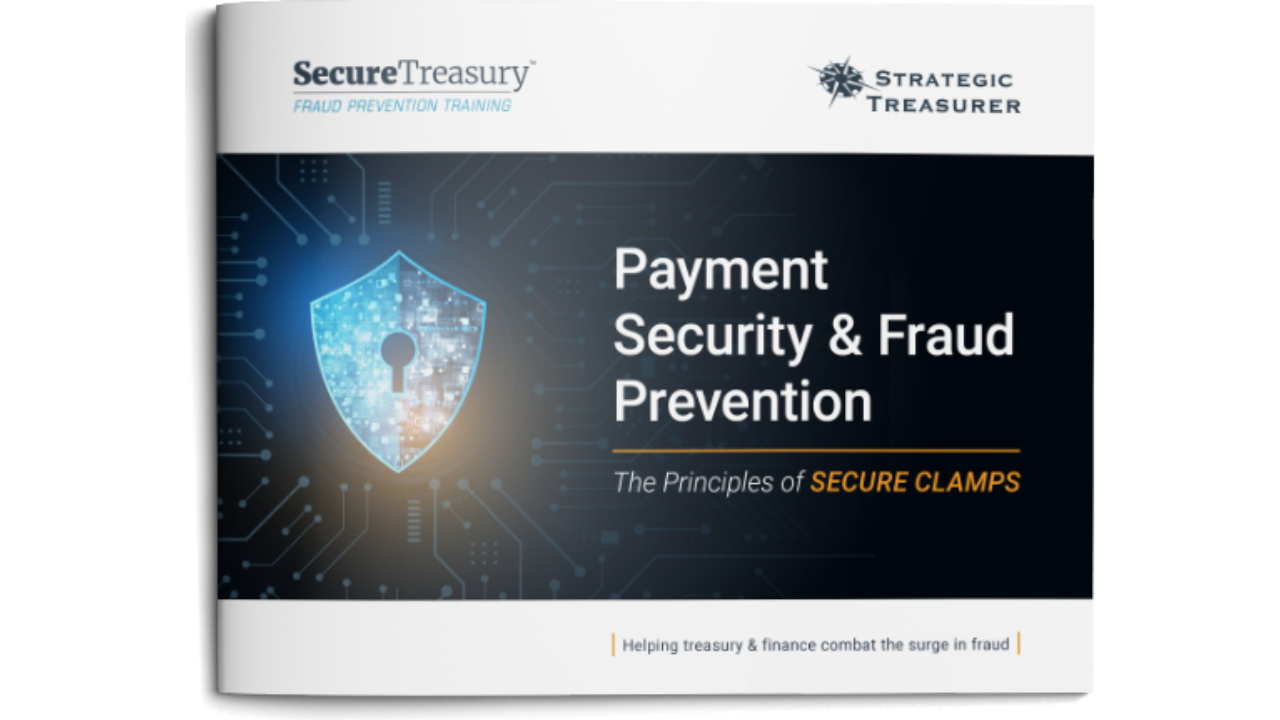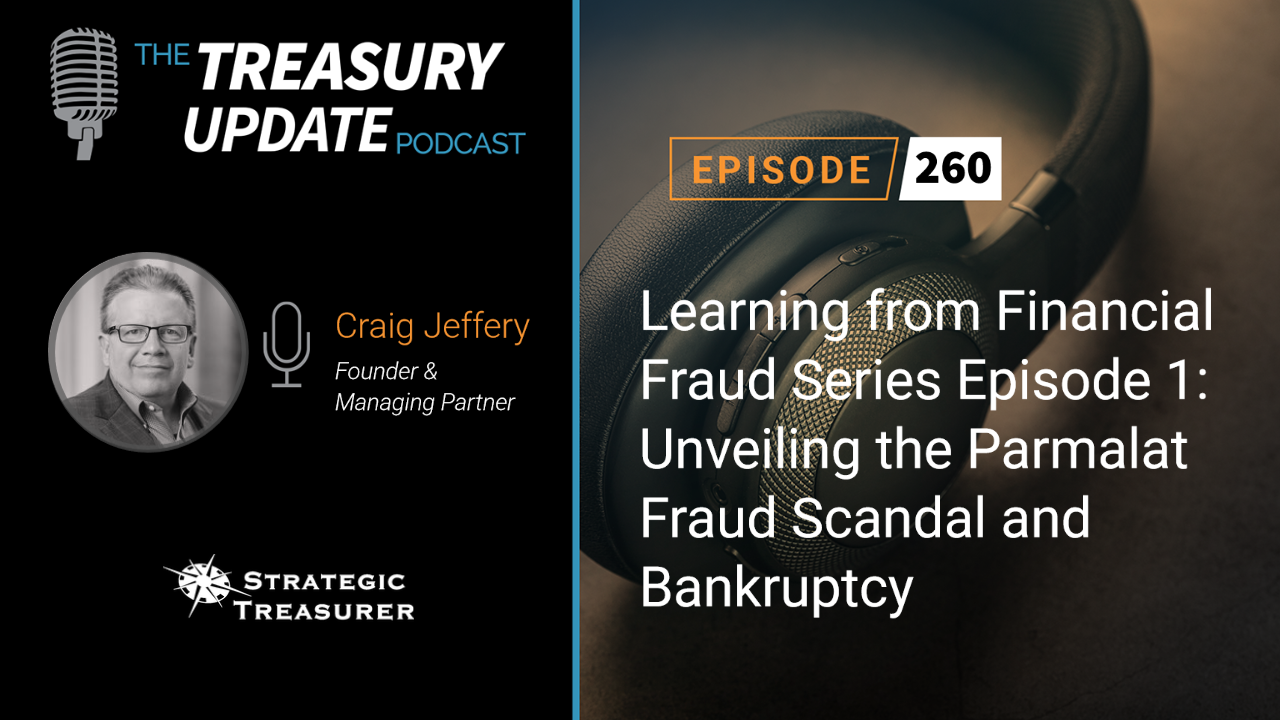
Episode 262
Learning from Financial Fraud Series Episode 2: Understanding the Satyam Scandal and Its Consequences
The Satyam scandal sent shockwaves through the industry, revealing a web of deceit within the renowned Indian IT services company that ultimately led to its collapse in 2009. By understanding the details shared in this case study, you will be better equipped in your role to safeguard your business against similar fraudulent practices. Listen in as Jason Campbell and Craig Jeffery discuss key takeaways from this scandal.
Host:
Jason Campbell, Strategic Treasurer


Speaker:
Craig Jeffery, Strategic Treasurer


Subscribe to the Treasury Update Podcast on your favorite app!
Episode Transcription - Episode # 262: Learning from Financial Fraud Series, Episode 2: Understanding the Satyam Scandal and Its Consequences
Announcer 00:04
Welcome to the Treasury Update Podcast presented by Strategic Treasurer, your source for interesting treasury news, analysis, and insights in your car, at the gym, or wherever you decide to tune in.
Jason Campbell 00:17
Welcome to the Learning From Financial Fraud Series on the Treasury Update Podcast. In this series, we will explore multiple major financial frauds and thefts to see how each one occurred, what was kept hidden for a period of time, and we’ll dissect how it was eventually discovered, and get insight and guidance on how to prevent this type of situation from happening at other companies or your company. I’m Jason Campbell, the host of this episode, I’m joined with Craig Jeffery, managing partner and founder of Strategic Treasurer. So let’s begin with episode number two, since the first one was fantastic, was great, we had some good dialogue, good conversation. And looking forward to the second piece of the series to talk about Satyam fraud, which was an Indian IT services and consulting firm in this fraud case. It was discovered back in January of 2009. And I know we had some, you know some conversations already about this particular case. And I’m pretty sure our audience is going to love to hear about the details in this particular scenario. So Craig, welcome to the show. And, you know, let’s talk about Satyam fraud and kind of talk about a little bit about the situation with it.
Craig Jeffery 01:22
This is really interesting. It was a huge Indian IT services consulting firm. And you know how this, you know, this fraud was uncovered? It was uncovered by a confession letter by the CEO, he had admitted to the fraud, resigned from his position. So this was not discovered through external sources. So just guilt I think guilt over time played a factor in this. But, but what was the situation? So this was this was a massive fraud. In India, one of the largest ones, I think, ever in India, I’m not sure what the ranking is, but it’s certainly up there. And this, this, like many of these, when they’re this significant, you know, north of a billion US, right, it was, like 71 billion rupees, which is about one one and a half billion US dollars. This creates a negative impact on the view of governance, the reputation of governance in the country, right, this this is what we see, every time there’s these significant items, the overall country faces a bit of a blowback for how was this allowed to happen? So, you know, this this came about from if you’re talking about a generally what we call financial misstatements, you know, cooking the books or recording things improperly, you know, terms like accounting, irregularities are common. But this was this was significant. And they, they were able to exfiltrate funds, get funds out of the organization, through several different means. But one of the ones that I found most surprising here is they created a massive number of fictitious employees that they paid. They had listed over 53,000 employees. I don’t remember what the number is of employees that were fake, but they had all these fake employees. And then the money would be transferred out via a payroll process to these different accounts. So huge, huge way of siphoning funds off. That was an issue. But they also they didn’t just send the funds off. They also created fictitious cash balances, they had cash balances, apparently of over a billion when they didn’t have those funds. This was really, really significant. And it wasn’t just, it wasn’t just Ramalinga Raju, who did it, the founder chairman. It was done in concert with others, right? So it was there was there was some collusion, they created fictitious invoices, fictitious payroll, they bumped up revenue figures, all of these things factored together. So it looked like hey, we have huge profits, huge amount of assets, they created a fictitious bank statement. So you know, paper bank statements. And they forged a number of different types of documents so that auditors and regulators would be like, Hey, this is, everything is fine. So there were key officials at Satyam, in addition to the Chairman CEO, who coordinated this activity, colluded on it, to fabricate these records and boost their their revenue figures. So this, this, this led to a long period of deceit that was discovered, again, from a confession letter, not from something else that had happened. So maybe it was impending that it was gonna be found out. I don’t really remember what the, you know, the sensitivity to his conscious came about, but he wrote a confession letter to that and resigned and the rest is recorded in the in the ether and the internet seeing what’s what’s out there.
Jason Campbell 04:45
I guess from a standpoint of like that the act of desperation for and especially to your leaders, right to a company leader that was in whatever financial situation that they ran dry and as the Chairman and CEO and you know, a lot of times it’s hard to say then like, again, questioning your executive leader in that aspect, right? Or, you know, and I’m gonna say, just in this aspect, I’m gonna just in general, I mean, it’s your boss, right? It’s the person that’s the face of your organization, right? And not knowing this behind the scenes and how scary this type of situation was. And you know what even it could have been even longer, you know, knowing like you said, the collusion that was going on and, you know, was discovered through just basically a confession letter of guilt or whatever may have been, or we could say, maybe it was killed.
Craig Jeffery 05:27
Well, and there wouldn’t, there wouldn’t necessarily be a reason to question the CEO, because what were they doing is like, the organization was doing well, making great profits. It was like, hey, everything’s success, its success upon success, or so it seems. And so why would you question that if it was more on the margins, and all of a sudden, it changed dramatically. So this whole, we continue to build this picture of, we’re making more and more money, we’re generating more and more revenue, making more and more profit, things are good and getting better. So that also creates a, an ability to hide that activity.
Jason Campbell 05:58
It’s like making a body of the company looking all nice and shiny look, well fit in place, but inside, it’s hollow, there’s nothing in there, right. So it’s just a very thin layer of beauty. But inside is a very dark and cold place. And, you know, and just really kind of creating that image, right, which was with that forgery, and that fictitious activities that were going on within that company. So, you know, so let’s talk about now that the, the CEO and Chairman had the resignation letter or confession letter and did resign, you know, resigned from his position, but I’m pretty sure just feeling like, you know, hey, I’m sorry, I did this. And I’m just gonna leave the company, bye. I’m pretty sure that wasn’t the only thing that occurred from, I guess, a consequence of these actions.
Craig Jeffery 06:42
No, it wasn’t just it wasn’t just shame. And I believe I’m trying to remember what happened with him in terms of going to jail. But yeah, it was certainly a very different, different situation. You can’t steal above a billion dollars without going to jail. I think in any, I would imagine. It’s pretty it’s it’s pretty, pretty significant. I mean, the good thing is he did he did at least clear his conscience at the end by writing the confession letter, right? This just just stacked up. So yeah, some some really, really interesting, like, not discovered externally, but by a confession letter.
Jason Campbell 07:18
So let’s go on into the results here of the fraud in this particular piece here. Let’s talk a little bit more about the company and outside of the just the active participants in this case.
Craig Jeffery 07:28
Yeah, so it was top of the organization, there was collusion going on. They created fake invoices, fake financial records of fake cash balances, created fictitious employees, used that to siphon funds. Yeah. So that’s like a, I don’t know how many that was four or five, six, I don’t know what that is, you know, what, what level of fictitious activity that they were doing, but it was quite a bit of fictitious, cooking the books, providing supporting documentation, making it so that it was easy to deceive the auditors and the regulators. You know, the whole, we create this, we say we have more cash, and yet we’re siphoning the cash off through what appears to be paying employees, right. So we have more revenue, we have more employees, those weren’t real employees, or not all of them were real employees. And they sent money to accounts that they control. So they’re able to siphon the money out of the organization, using the regular standard processes that people in those roles may not have known about some of them, right? We’re just paying employees, right? There’s more employees, they’re set up on a system. They’re getting paid. It’s really just siphoning funds off the organization. So that’s some of the biggest elements about, you know, how they pulled it off and the impact of that.
Jason Campbell 08:37
So add, so now after it’s all been exposed, and everything’s been opened up now, so let’s talk about like, what’s the aftermath? What happened there?
Craig Jeffery 08:44
In the aftermath, aftermath of that there was the impact on the country, what they did for trying to provide better, better oversight, better controls. Every country that has experienced these major major frauds, there’s some type of regulations that follow it. One issue creates regulations for everyone to follow, right, to prevent the significant item. So that was one significant. The second was, this was a huge loss, a huge loss of funds for Mahindra Satyam, owner of Satyam Computer Services Limited. And so there’s a big loss of income for everybody who invested in it, whoever invested in that organization, and, you know, the negative impact was significant. So certainly people were impacted who worked there who had nothing to do with it, in terms of people losing, they’re losing their jobs, audit firms not not having found and discovered something so significant. So those were those are some of the the impacts.
Jason Campbell 09:40
You know, it’s funny you were talking about for government to put in regulations because of a result and I think that’s unfortunate that you have to you have to put in you know, or when processes or regulations or fixes go into place after a an occurrence of something of anything, right whether it’s, you always think about like the traffic you know, you’re driving And then down the road, you’re like, oh my gosh, this intersection is something really bad it’s gonna happen. Well, sometimes it takes for that to happen in order something to be done. I know that sounds a little, it’s just reality, right? I know, it sounds a little bad. But in the sense of, you know, you don’t need the car crash to occur to fix something. You could have fixed it all along by knowing, Hey, what’s you know, as we’re designing, and as we’re looking at building a blueprint of it is being able to understand, you know, where are those weaknesses within within a process or design itself to ensure that you’re looking at everything from a 360 perspective? Because a lot of times, you gotta, you got to think like a criminal. You know, it’s like, well, I’m not a criminal. But sometimes you got to think like that, because there’s people who are, who are going to try that. They’re going to try to find those things in every in our everyday lives. And I think for organizations to be able to continue to test, you know, to continue to look at ways to say, you know, how would a criminal try to attack us and these ways and how, you know, because obviously, they’re trying to gain financial advancement somehow. So, you know, it’s relating to where the cash flow is to knowing, you know, how do we put parameters? How do we put barriers? How do we put things in place, which kind of in this situation, I’d love to get your take is, how could, how could have this type of fraud been prevented?
Craig Jeffery 11:14
One thing is, many people write confession letters every month, what did you do wrong? And then you could say, oh, I stole, I’m sorry, I’m being all smart about that. But but you can certainly put in many, many companies do, you know, a fraud hotline, or an ethics hotline. Is there somebody doing something that’s very unethical, you know, not, not proper. And you can make those anonymous or you can make those reported. So having this fraud hotline allows people to report stuff that they might not feel comfortable, especially if it’s at the top of the organization, you can report it, it goes to multiple people who will do the follow up, and then it’s, then it’s discoverable, it’s discovered. So fraud hotline, anonymous tip lines are really worthwhile. And it’s these kinds of situations where, hey, it’s being covered up because collusion is really difficult to uncover because usually these are done by senior people who understand the process flows, maybe even have some sign off, and so they’re able to keep it undiscovered, that’s one. The second is you have to maintain better or good control of your master record information for payroll, for accounts payable, even on the receivable side. That involves having segregation of duties. Who can request things? Who sets things up? How does that get reported? So all these fictitious employees. Who are they reporting to? Who’s overseeing that? And a validation of that, right? Confirmation that someone’s working, someone’s doing that activity. So controlling master data records is a secondary one. And the other is what I mentioned on our our first situation with Parmalat is that the whole bank account management and full visibility to cash. So every bank account you have globally that should be reported in digitally, and organizations should see see where the cash is. So when someone’s reporting, we’ve got 2 billion of cash, and he really only have 500 million, where is the difference? That’s not just timing, there’s no timing differences. There’s, there’s a significant gap that needs to be explained and hunted down. Having that type of visibility on a daily basis is a, what we would consider a minimum standard. That’s commercially reasonable to do that. Everybody who has said in the past, no, let’s, let’s make a business case for why we get that information reported on a daily basis. No, it is not acceptable. And you can see in cases like this, that doesn’t make sense there. And it also makes sense to say that’s a cost of doing business. I have accounts, I will have pure visibility. And then and then on the bank account management side, controlling who has access to accounts, what those accounts are, when they’re set up, and managing that process rigorously. Everything from who has portal access to who are active signers, those are, those are foundational structural considerations to protect, you know, where the most liquid assets, the organization are.
Jason Campbell 13:59
You’re gonna talk about the ethics hotline, you know, and I think that’s a great tool, especially for like, your executives, right, and you knowing something’s going on or whatnot. And, you know, they’re not saying that all executives are going to steal. But again, it’s a free, you know, when you think about, you know, you don’t want to have the backlash of the recourse but also you know that the there’s something that’s definitely not right, that somebody definitely needs to be well aware of, so there’s those are all great valid points there. Well, Craig, thank you so much for, for talking with us on this episode and talking about Satyam’s fraud case here. There was a lot of great information, hopefully some great learnings that our listeners got out of this. So we’re really excited to again, have this conversation for our second episode in this series. And for our listeners that thank you for tuning in to the second episode and learning about Satyam’s fraud case and understanding the magnitude of this particular case and, you know, kind of ways to prevent it not only hopefully, in your organization, but also for other companies that, you know, could potentially use some of that advice as well. So, again, Craig, thank you so much for joining us today. And listeners, please join us for our next episode, where we’re going to talk a little bit more into a wire card fraud case in the third episode of this series, so hopefully you guys will tune in for that. Until next time, take care.
Announcer 15:16
You’ve reached the end of another episode of the Treasury Update Podcast. Be sure to follow Strategic Treasurer on LinkedIn. Just search for Strategic Treasurer. This podcast is provided for informational purposes only, and statements made by Strategic Treasurer LLC on this podcast are not intended as legal, business, consulting, or tax advice. For more information, visit and bookmark StrategicTreasurer.com.
Related Resources
Welcome to the Learning from Financial Fraud Series, where we will explore multiple major financial frauds and thefts to see how each one occurred, was kept hidden, and was eventually discovered. Today we are exploring one of the largest financial scandals in Italian history, the Parmalat fraud case. This scandal led to the Italian dairy and food company’s 2003 bankruptcy. Discover how the fraud occurred, its impact, and learn preventive measures. Join Jason Campbell and Craig Jeffery as they discuss some of the key points behind this significant corporate fraud.








